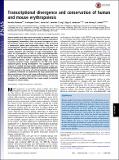| dc.contributor.author | Pishesha, Novalia | |
| dc.contributor.author | Prathapan, Thiru | |
| dc.contributor.author | Jiahai, Shi | |
| dc.contributor.author | Eng, Jennifer Christina | |
| dc.contributor.author | Sankaran, Vijay G. | |
| dc.contributor.author | Lodish, Harvey F | |
| dc.date.accessioned | 2014-11-04T14:14:23Z | |
| dc.date.available | 2014-11-04T14:14:23Z | |
| dc.date.issued | 2014-03 | |
| dc.date.submitted | 2013-02 | |
| dc.identifier.issn | 0027-8424 | |
| dc.identifier.issn | 1091-6490 | |
| dc.identifier.uri | http://hdl.handle.net/1721.1/91281 | |
| dc.description.abstract | Mouse models have been used extensively for decades and have been instrumental in improving our understanding of mammalian erythropoiesis. Nonetheless, there are several examples of variation between human and mouse erythropoiesis. We performed a comparative global gene expression study using data from morphologically identical stage-matched sorted populations of human and mouse erythroid precursors from early to late erythroblasts. Induction and repression of major transcriptional regulators of erythropoiesis, as well as major erythroid-important proteins, are largely conserved between the species. In contrast, at a global level we identified a significant extent of divergence between the species, both at comparable stages and in the transitions between stages, especially for the 500 most highly expressed genes during development. This suggests that the response of multiple developmentally regulated genes to key erythroid transcriptional regulators represents an important modification that has occurred in the course of erythroid evolution. In developing a systematic framework to understand and study conservation and divergence between human and mouse erythropoiesis, we show how mouse models can fail to mimic specific human diseases and provide predictions for translating findings from mouse models to potential therapies for human disease. | en_US |
| dc.description.sponsorship | National Institutes of Health (U.S.) (Grant P01 HL32262) | en_US |
| dc.description.sponsorship | American Association of University Women (Fellowship) | en_US |
| dc.description.sponsorship | Philanthropic Educational Organization (International Peace Scholarship Fund) | en_US |
| dc.description.sponsorship | Schlumberger Foundation. Faculty for the Future | en_US |
| dc.language.iso | en_US | |
| dc.publisher | National Academy of Sciences (U.S.) | en_US |
| dc.relation.isversionof | http://dx.doi.org/10.1073/pnas.1401598111 | en_US |
| dc.rights | Article is made available in accordance with the publisher's policy and may be subject to US copyright law. Please refer to the publisher's site for terms of use. | en_US |
| dc.source | PNAS | en_US |
| dc.title | Transcriptional divergence and conservation of human and mouse erythropoiesis | en_US |
| dc.type | Article | en_US |
| dc.identifier.citation | Pishesha, N., P. Thiru, J. Shi, J. C. Eng, V. G. Sankaran, and H. F. Lodish. “Transcriptional Divergence and Conservation of Human and Mouse Erythropoiesis.” Proceedings of the National Academy of Sciences 111, no. 11 (March 3, 2014): 4103–4108. | en_US |
| dc.contributor.department | Massachusetts Institute of Technology. Department of Biological Engineering | en_US |
| dc.contributor.department | Massachusetts Institute of Technology. Department of Biology | en_US |
| dc.contributor.department | Whitehead Institute for Biomedical Research | en_US |
| dc.contributor.mitauthor | Pishesha, Novalia | en_US |
| dc.contributor.mitauthor | Lodish, Harvey F. | en_US |
| dc.relation.journal | Proceedings of the National Academy of Sciences | en_US |
| dc.eprint.version | Final published version | en_US |
| dc.type.uri | http://purl.org/eprint/type/JournalArticle | en_US |
| eprint.status | http://purl.org/eprint/status/PeerReviewed | en_US |
| dspace.orderedauthors | Pishesha, Novalia; Thiru, Prathapan; Shi, Jiashi; Eng, Jennifer C.; Sankaran, Vijay G.; Lodish, Harvey F. | en_US |
| dc.identifier.orcid | https://orcid.org/0000-0002-7029-7415 | |
| dc.identifier.orcid | https://orcid.org/0000-0001-9306-8271 | |
| mit.license | PUBLISHER_POLICY | en_US |
| mit.metadata.status | Complete | |
